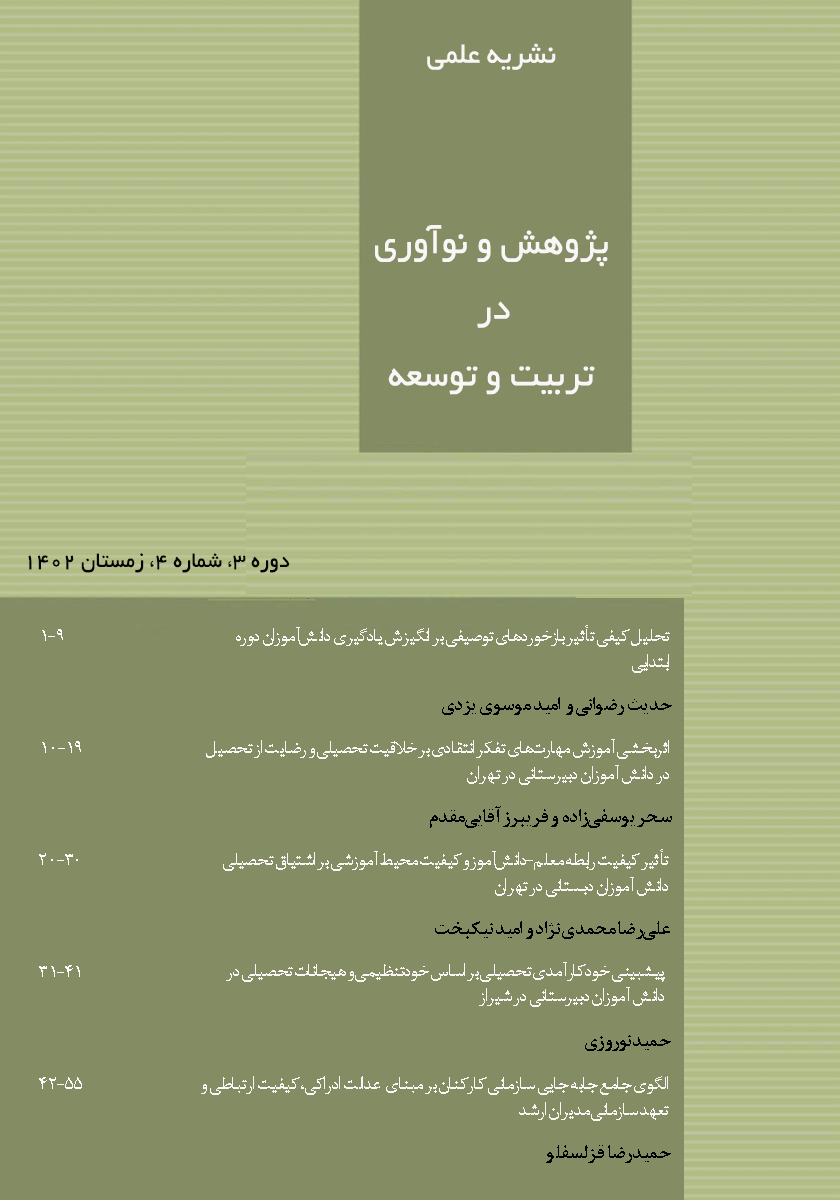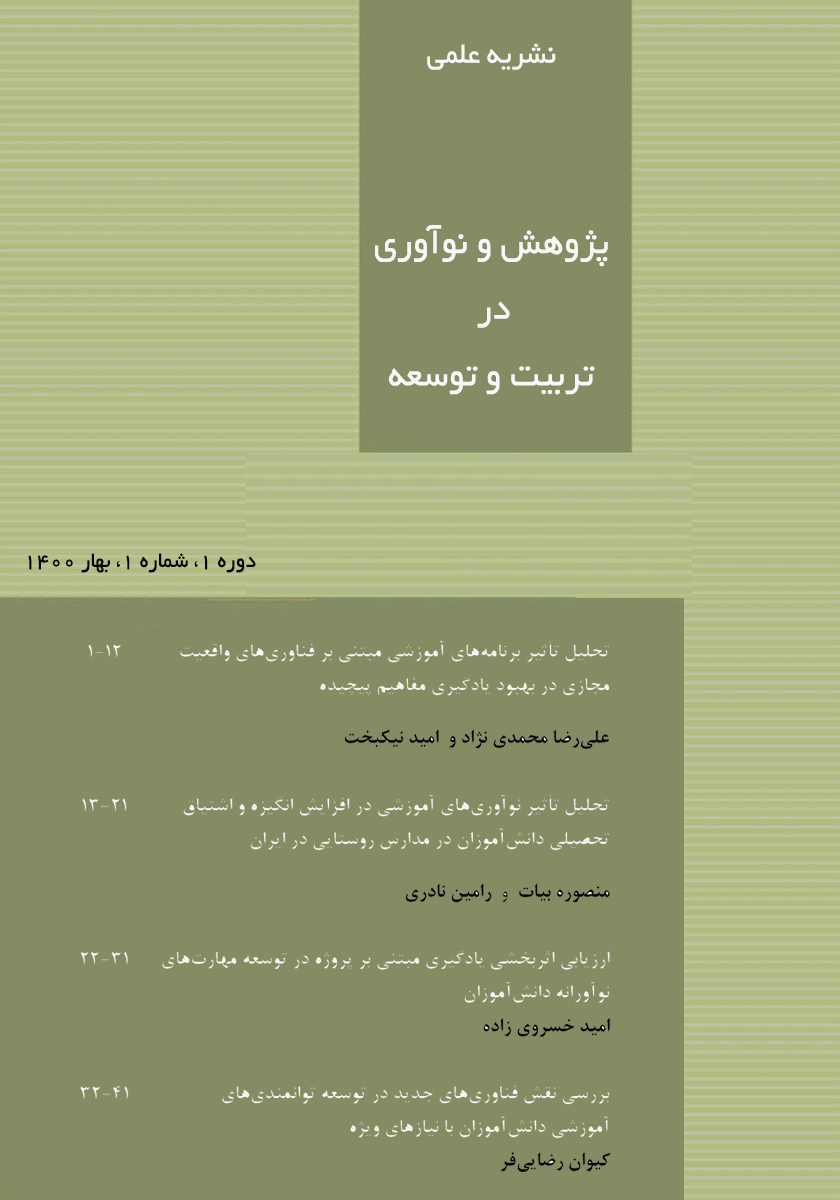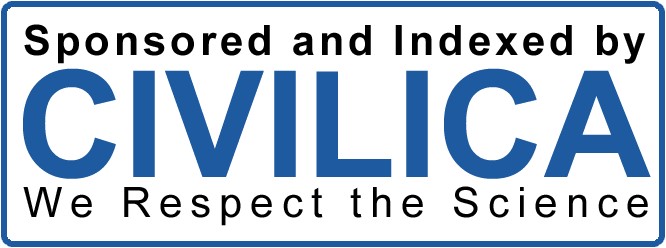اثربخشی آموزش مهارتهای تفکر انتقادی بر خلاقیت تحصیلی و رضایت از تحصیل در دانش آموزان دبیرستانی در تهران
کلمات کلیدی:
تفکر انتقادی, رضایت از تحصیل, دانشآموزان دبیرستانی, آموزش و پرورش, مطالعه نیمهآزمایشیچکیده
هدف از این پژوهش بررسی اثربخشی آموزش مهارتهای تفکر انتقادی بر خلاقیت تحصیلی و رضایت از تحصیل در دانشآموزان دبیرستانی در تهران بود. این مطالعه به دنبال آن بود که نشان دهد آیا آموزش مهارتهای تفکر انتقادی میتواند به بهبود خلاقیت تحصیلی و افزایش رضایت از تحصیل دانشآموزان منجر شود یا خیر. این پژوهش از نوع نیمهآزمایشی با طرح پیشآزمون-پسآزمون با گروه کنترل بود. 30 دانشآموز دبیرستانی بهطور تصادفی به دو گروه آزمایش (15 نفر) و کنترل (15 نفر) تقسیم شدند. گروه آزمایش در 10 جلسه 60 دقیقهای آموزش مهارتهای تفکر انتقادی شرکت کردند، در حالی که گروه کنترل هیچ مداخلهای دریافت نکرد. دادهها با استفاده از پرسشنامههای خلاقیت تحصیلی و رضایت از تحصیل در سه مرحله پیشآزمون، پسآزمون و پیگیری (پنج ماه پس از مداخله) جمعآوری و با استفاده از تحلیل واریانس با اندازهگیریهای مکرر و آزمون تعقیبی بونفرونی تحلیل شدند. نتایج نشان داد که آموزش مهارتهای تفکر انتقادی بهطور معناداری باعث افزایش خلاقیت تحصیلی و رضایت از تحصیل در گروه آزمایش شد. میانگین نمرات خلاقیت تحصیلی و رضایت از تحصیل در گروه آزمایش از پیشآزمون به پسآزمون و پیگیری افزایش یافت، در حالی که در گروه کنترل تغییرات معنیداری مشاهده نشد. نتایج تحلیل واریانس و آزمون تعقیبی بونفرونی تفاوتهای معنیداری بین گروهها و مراحل مختلف آزمون را نشان داد. این پژوهش نشان داد که آموزش مهارتهای تفکر انتقادی میتواند بهطور مؤثری به افزایش خلاقیت تحصیلی و رضایت از تحصیل دانشآموزان کمک کند. این نتایج اهمیت بهکارگیری روشهای آموزشی فعال و مشارکتی در مدارس را برجسته میکند و نشان میدهد که آموزش تفکر انتقادی میتواند به بهبود عملکرد تحصیلی و افزایش انگیزه دانشآموزان منجر شود.
دانلودها
مراجع
Al-Mahdawi, N., & Al-Smadi, O. (2019). The potential of raft strategy for improving
Jordanian EFL students' creative writing. Lublin Studies in Modern Languages and
Literature, 43(4), 105. https://doi.org/10.17951/lsmll.2019.43.4.105-113
Al-Oweidi, A. (2013). Creative characteristics and its relation to achievement and
school type among Jordanian students. Creative Education, 04(01), 29-34.
https://doi.org/10.4236/ce.2013.41004
Anh, N., Biên, N., Dang, V., & Khuyên, N. (2022). STEM clubs: The promising
space to foster students’ creativity. International Journal of STEM Education for
Sustainability, 2(1), 45-52. https://doi.org/10.53889/ijses.v2i1.22
Auliyah, N., Sudibyo, E., & Munasir, M. (2021). Analysis of junior high school
students' creative thinking skills in distance learning. IJORER International Journal of
Recent Educational Research, 2(3), 316-328. https://doi.org/10.46245/ijorer.v2i3.111
Bower, J. (2023). Measuring creativity in academic writing: An analysis of essays
in advanced placement language and composition. Journal of Advanced Academics, 34(3-
, 183-214. https://doi.org/10.1177/1932202x231211633
Bojulaia, M., & Pleasants, B. (2021). Saudi high school STEM teachers’
understanding and practices of creativity in the classroom. Journal of Research in Science
Mathematics and Technology Education, 4(3), 179-203.
https://doi.org/10.31756/jrsmte.432
Bollimbala, A., James, P., & Ganguli, S. (2019). Impact of acute physical activity
on children's divergent and convergent thinking: The mediating role of a low body mass
index. Perceptual and Motor Skills, 126(4), 603-622.
https://doi.org/10.1177/0031512519846768
Chifamba, T., & Wijaya, C. (2020). Creativity in relation to academic and clinical
performance of dentistry students. Asian Journal of Education and Social Studies, 1-7.
https://doi.org/10.9734/ajess/2020/v8i130209
Fielding, W., & Johnson, P. (2019). Do teachers influence high school students’
creativity? The experience of university students in the Bahamas. International Journal of
Bahamian Studies, 25, 16. https://doi.org/10.15362/ijbs.v25i0.341
Fuentes, M., Jurado, M., Ruíz, N., Márquez, M., & Linares, J. (2019). Relationship
between digital creativity, parenting style, and adolescent performance. Frontiers in
Psychology, 10. https://doi.org/10.3389/fpsyg.2019.02487
Ghadimi, A., Abdoltajedini, P., & Nasab, D. (2020). The effectiveness of PRIZ
creativity training program on the individual-social adaptation of high school students in
Shabestar. Iranian Journal of Educational Sociology, 3(1), 34-42.
https://doi.org/10.52547/ijes.3.1.34
Goni, U., & Tambawal, M. (2013). Relationship between creativity and self-concept
on students’ academic achievement in Borno state college of education: Implications for
counseling. Sokoto Educational Review, 14(2), 8. https://doi.org/10.35386/ser.v14i2.117
Kauts, D., & Kauts, A. (2021). Effect of Taba's inductive thinking model on
achievement in science and creative thinking in relation to intelligence of students at
secondary school stage. Mier Journal of Educational Studies Trends & Practices, 151-166.
https://doi.org/10.52634/mier/2020/v10/i2/1347
Liang, Q., Niu, W., Li, C., & Qin, K. (2021). Creativity outside school: The influence
of family background, perceived parenting, and after‐school activity on creativity. The
Journal of Creative Behavior, 56(1), 138-157. https://doi.org/10.1002/jocb.521
Ren, F., & Zhang, J. (2023). Reciprocal relations between autonomous motivation
and creativity: A longitudinal investigation of Chinese children and adolescents.
Psychology of Aesthetics Creativity and the Arts. https://doi.org/10.1037/aca0000544
Sharma, R. (2016). Effect of school and home environments on creativity of
children. Mier Journal of Educational Studies Trends & Practices, 187-196.
https://doi.org/10.52634/mier/2011/v1/i2/1614
Supardi, Z., & Jatmiko, B. (2017). Feasibility of creative exploration, creative
elaboration, creative modeling, practice scientific creativity, discussion, reflection
(C3PDR) teaching model to improve students’ scientific creativity of junior high school.
Journal of Baltic Science Education, 16(6), 1020-1034.
https://doi.org/10.33225/jbse/17.16.1020
Wurdinger, S., & Enloe, W. (2011). Cultivating life skills at a project-based charter
school. Improving Schools, 14(1), 84-96. https://doi.org/10.1177/1365480211399749












